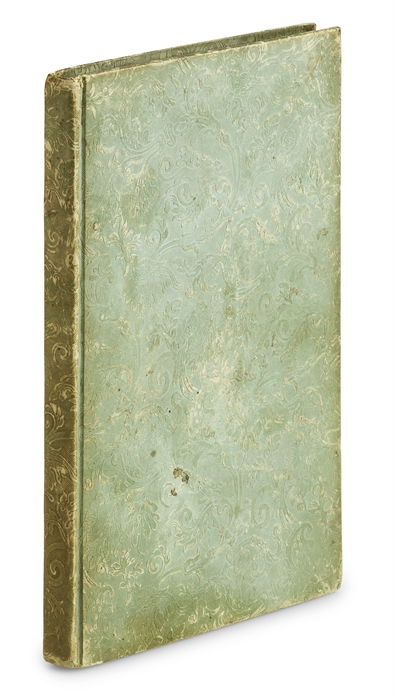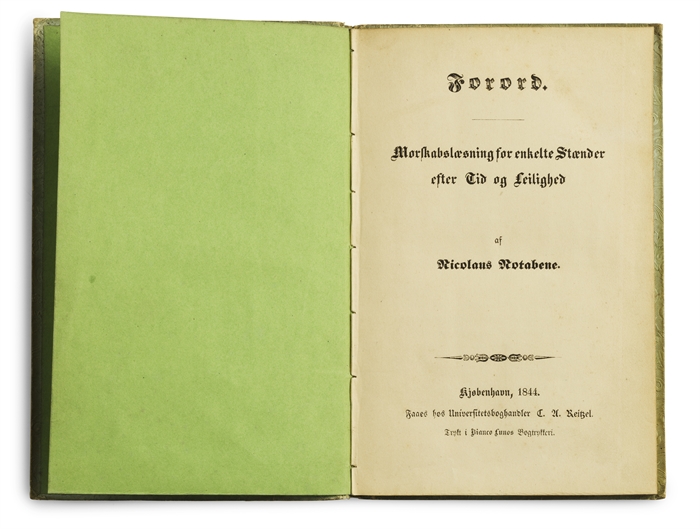KIERKEGAARD’S OWN COPY - ONE OF THE TWO COPIES HE HAD MADE FOR REGINE AND FOR HIMSELF
KIERKEGAARD, SØREN.
Forord. Morskabslæsning for enkelte Stænder efter Tid og Leilighed af Nicoilaus Notabene.
Kjøbenhavn, Reitzel, 1844.
Small 8vo. 110, (1) pp. Splendidly bound in beautiful ornamental mint green patterned paper over boards with branches, flowers, birds, squirrels, and dogs in a relief-pattern. Green end-papers and all edges gilt. Printed on fine vellum-paper. Slight soiling to spine and a bit of wear to paper on spine and over boards, where the relief is high. But a splendid, tight copy with no restorations and absolutely minimal brownspotting.
Back pasted-down end-paper with a later, neat pencil-inscription from the previous owner stating that this is Kierkegaard’s own copy, bought by Høedt at the auction after Kierkegaard’s death and stating where the previous owner found the copy in 1995.
Housed in a beautiful marbled paper box with richly gilt greenish morocco spine in ornamental pastichestyle with a red gilt leather title-label with Gothic gilt lettering. Gilt super ex-libris to front board (Anker Kysters Eftf., gilt by Hagel Olsen).
The most splendid copy of the first edition possible, namely Kierkegaard’s own copy, one of the two copies he had printed on special paper and specially bound, one for Regine, one for himself. This is Kierkegaard’s own copy that he kept himself, from the love-set of the two copies of Prefaces he had made, where the other was for Regine. One of the two copies of the book that he had made on special paper and bound in this particularly beautiful and romantic binding. Kierkegaard had his eight pseudonymous works made like this, one for Regine, one for himself. So far, only four of these have surfaced, Regine’s copies of Repetition, Prefaces, and Either-Or (all sold at auction in 2002), and Kierkegaard’s own copy of Either-Or (in the Danish Royal Library). The other copies are unregistered, and the whereabouts unknown. The present copy is presumably that described merely as “dainty w. gilt edges”, nr. 2133 from the auction catalogue of Kierkegaard's books sold after his death. Published simultaneously with The Concept of Anxiety, Prefaces can be viewed as its companion piece. It represents an altogether different genre and is the most humorous of all of Kierkegaard’s works, but the two fictional authors of the works interestingly contrast each other. Although having been eclipsed by the now notoriously famous Concept of Anxiety, Prefaces was in fact more popular when it appeared and sold many more copies. Written under the pseudonym of Nicolaus Notabene, the “author” name indicates that despite its humorous approach, Prefaces is still something serious – something to be noted. And it certainly is. It is here that we find Kierkegaard’s sarcastic roasting of the Hegelian system and of the Danish Hegelians with Johan Ludvig Heiberg as the main representant. Through Notabene, he makes fun of Heiberg and Hegel, who both want to explain everything and want to be mediators of understanding. Just as Hafniensis in The Concept on Anxiety poses that “how sin came into the world each man understands solely by himself. If he would learn it from another, he would misunderstand it” (p. 51), so Notabene in Prefaces states that “My frame, my health, my entire constitution do not lend themselves to mediation” (p. 45). In Prefaces we also find Kierkegaard’s thoughts about the relationship between the reading public and the author and his fierce criticism of literary critics and reviewers, among these also Heiberg as well as Martensen, who famously reviewed Either-Or and Repetition respectively. And in the very amusing preface to the Prefaces, we are given another glimpse into Kierkegaard’s thoughts on marriage and the dilemma he found himself in with Regine – the inner struggle between he, who is the husband, and he, who is the author; can one be both? With its challenging notions on the idea of the book and the interaction of the book with its readers, his little ironic masterpiece is a clear forerunner of Postmodernism. “Kierkegaard’s ‘Prefaces’ is a brief though not unimportant work. Themes he develops elsewhere at greater length here are presented with characteristic insight and wit. This richly suggestive text has never received the attention it deserves. William McDonald’s fine translation now makes it possible to assess the importance of ‘Prefaces’ for Kierkegaard’s œuvre and to appreciate its significance for philosophical, literary, and theological issues that are still with us.” (From the review of William McDonald’s 1989 edition of Prefaces in English in the Kierkegaard and Postmodernism-series). Written under a pseudonym and without Kierkegaard’s name appearing as publisher or indeed as anything else, he was unable to give away presentation-copies of the work (due to his own strict set of rules for this). Thus, not a single presentation copy of the work exists. A single copy of the book was in the auction catalogue of his book collection after his death – described as in a dainty binding and with all edges gilt. Like Repetition and his other seven pseudonymous works, Prefaces, was printed in two copies both on vellum-paper and bound in special bindings, one for Regine, one for Kierkegaard himself. 24 years ago, three of these books surfaced, at an auction in 2002, namely Either-Or, Repetiton, and Prefaces, all being the copies Kierkegaard had bound for Regine. Before that, only one single copy of one of these eight titles for Kierkegaard himself or for Regine were known (namely Kierkegaard’s own copy of Either-Or, which is in the Danish Royal Library). Seven of the books, Kierkegaard’s own copies, were listed in the auction catalogue after his death, but apart from the mentioned copy of Either-Or in the Royal Library, the others had not been found. Kierkegaard’s wildly famous love story and failed engagement to Regine Olsen plays a pivotal role throughout Kierkegaard’s entire life and work. It all begins in 1837, when Kierkegaard meets the lovely young girl Regine Olsen at a visit to the widowed Cathrine Rørdam. Three years later, in September 1840, after having corresponded frequently with her and visited her on numerous occasions, Kierkegaard decides to ask for her hand in marriage. She and her family accept, but the following day, Kierkegaard regrets his decision and ends up finally breaking off the engagement in October 1841. Disregarding the scandal, the heartbreak (his own included), and the numerous pleas from family members and friends alike, Kierkegaard’s tortured soul, still searching for God and for the meaning of faith, cannot continue living with the promise of marriage. Later the same month, he flees Copenhagen and the scandal surrounding the broken engagement. He leaves for Berlin, the first of his four stays there, clearly tortured by his decision, but also intent on not being able to go through with the engagement. As is evident from his posthumously published Papers, Kierkegaard’s only way out of the relationship was to play a charming, but cold, villain, a charlatan, not betraying his inner thoughts and feelings. Despite the brevity of the engagement, it has gone down in history as one of the most significant in the entire history of modern thought. It is a real-life Werther-story with the father of Existentialism as the main character, thus with the dumbfounding existentialist outcome that no-one could have foreseen. This exceedingly famous and difficult engagement became the introduction to one of the most influential authorships in the last two centuries. “She was the reason for my authorship”, Kierkegaard writes in his Papers, and there is no doubt that several of his most significant works are born out of the relationship with Regine – and its ending. It is during his stay in Berlin, his first of four altogether, right after the rupture of the engagement, that he begins writing Either-Or, parts of which can be read as an almost autobiographical rendering of his failed engagement. After a couple of years, Regine got engaged to someone else, whom she married in 1847. But as is well known, Kierkegaard never married, and the impact of his engagement to Regine and what it made him understand – about himself, about religion, faith, the inner workings of the philosopher and the poet –, never lost its significance. It is evident from the many drafts of a letter that he sent to Regine, through her husband, in 1849 (which was returned to him, unopened) that he had never lain the matter to rest and that the relationship with Regine was still very much alive. He also states in his Notebook 15 from 1849 “By the way, it is certainly the case that my relationship with her has been a very close, present study for me of what faith is. For I know better in this relationship how it is apparently the exact opposite of the foundational. That I have lasted in this relationship has been useful for me in relating to God as a believer.” In his Notebook 15, also known as My Relationship with Her, from 1849, Kierkegaard describes how, when he finally broke off the engagement and she tried to get him to stay, she had told him “that she would thank me her entire life for being allowed to stay with me, even if she were to live in a little cupboard” (SKS No. 16: 6). Thus, Kierkegaard had a little cupboard made, with no shelves in it. Here, he kept “everything that reminds me of her and will remind me of her. There is also a copy of the pseudonyms (i.e. the works that he wrote under a pseudonym); of these, there were always only two copies on vellum-paper, one for her and one for me.” (SKS: Not. 15:6.). In all, Kierkegaard wrote eight pseudonymous books, Prefaces being one of them, all of which were evidently printed in two copies each on vellum-paper and bound in special bindings, one for Regine, one for Kierkegaard himself. Himmelstrup 70 The present copy is no. 27 in Girsel's "Kierkegaard" (The Catalogue) which can be found here.
Order-nr.: 62262


